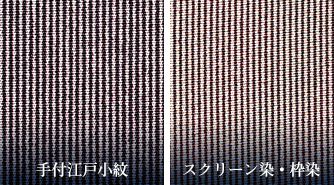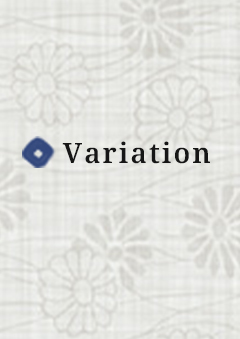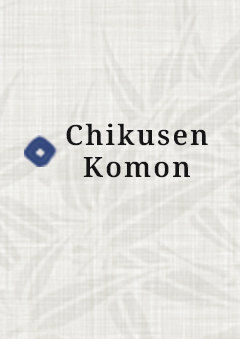Chikusen Kimono
Edo Komon
The term “Edo Komon” was officially coined by the Japanese government in 1954 (Showa 29), when the technique was designated as an Important Intangible Cultural Property. The name was created to distinguish Edo-style komon from the Kyoto-style komon.
Originally, the Edo Komon pattern—known as Sadame Komon—was used exclusively for kamishimo, the formal wear of samurai. Over time, however, as artisans refined their techniques, these intricate patterns found their way into the everyday clothing of townspeople.
This “democratization of fashion” gave rise to a wide variety of komon designs. The ingenuity of the common people—who drew motifs from every corner of the natural and cultural world—is truly remarkable.
Chikusen’s Edo Komon
At Chikusen, we have always relied solely on handcraftsmanship. Nowadays, a variety of production methods exist, and not all Edo Komon fabrics use the traditional 1.5-chōban or 3-chōban stencils. (These refer to specific stencil sizes.)
But the true essence of Edo Komon lies not only in the ability to dye repeat patterns (warimono) with perfect precision. The subtle “breath” of the artisan—their rhythm, touch, and individuality—is imprinted in the work, creating a unique charm. At Chikusen, we are dedicated to crafting garments that evoke that very feeling.
Tetsuke Edo Komon

Edo Komon traces its origins to the Edo period, where its intricate designs were used on the kamishimo—formal attire worn by samurai.
Over time, these patterns evolved and became widely embraced as traditional garments for women.One of the defining qualities of Edo Komon lies in its subtlety. Unlike patterns that stand out from a distance, such as those found in Kyoto's Yuzen dyeing—which is known for its bold motifs and vivid colors—Edo Komon features finely detailed, understated designs, often created using delicate stencil work like kiri-bori (drilled carving).
The charm of Edo Komon comes from its playful and imaginative motifs, its intricate details, and its refined elegance. These elements are essential to truly understanding its appeal. Due to the extraordinary level of craftsmanship involved, Edo Komon is considered one of the most difficult dyeing techniques. Today, only a handful of artisans, often referred to as true masters, continue to produce Edo Komon using traditional methods passed down through generations.
At our company, we are proud to present only hand-dyed Edo Komon garments, created exclusively by skilled artisans, including recipients of the prestigious title “Contemporary Master Craftsman.
” We understand that it can be difficult to distinguish, at first glance, between genuine hand-dyed fabrics and those produced using methods such as auto-screen or frame dyeing. To help illustrate the difference, we have published a side-by-side comparison of hand-dyed and screen-dyed komon on our website.
The true beauty of hand-dyed Edo Komon reveals itself when worn. Even with simple patterns, the garment naturally complements the contours of the face and body, offering a subtle elegance and depth that cannot be replicated by printing. This unique quality comes from the slight three-dimensional texture that only handwork can achieve.
We invite you to take a closer look and experience the difference—the delicate nuance of craftsmanship. While the majority of Edo Komon garments currently on the market are screen- or frame-dyed, please rest assured that every piece certified by our company is entirely hand-dyed.




